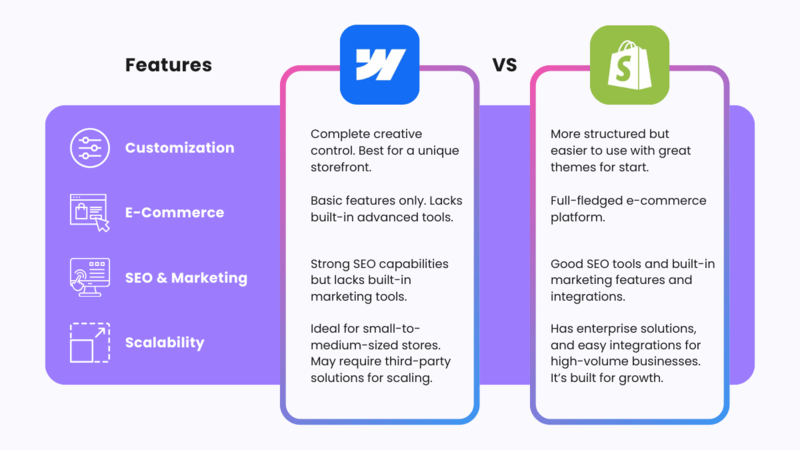Choosing the right platform is one of the most critical decisions an entrepreneur makes when launching and scaling an e-commerce business. While many options are available, two popular contenders—Webflow and Shopify—stand out for their unique strengths.
Webflow is known for its powerful design flexibility and no-code development capabilities, making it a favorite among designers and businesses prioritizing customization. On the other hand, Shopify is the go-to choice for many e-commerce businesses. It offers a comprehensive suite of tools for efficient online selling, from inventory management to payment processing.
But which platform is the best fit for your business model? This comparison will help you understand the key differences, strengths, and limitations of Webflow and Shopify so you can make the best decision for your business.
Let’s dive in.
Overview: Webflow
Webflow is a visual web design and development platform that allows users to create highly customizable websites without coding. It offers a powerful CMS, complete design flexibility, and the ability to build custom interactions and animations. While Webflow has e-commerce capabilities, it is primarily a website builder first and an online store platform second.
Webflow is the best platform for:
- Businesses that prioritize unique, custom website design
- Brands that want complete control over visual and interactive elements
- Companies with a design-heavy approach to branding
- Smaller e-commerce businesses with simpler product catalogs
At the same time, Webflow has its limitations:
- E-commerce features are less advanced than Shopify
- No built-in multi-currency support (requires workarounds)
- Limited payment gateway options compared to Shopify
- There is a steeper learning curve for those unfamiliar with web design
Overview: Shopify
Shopify is a dedicated e-commerce platform designed to help businesses sell online efficiently. It provides a comprehensive suite of built-in features, including product management, payment processing, inventory tracking, and a vast ecosystem of apps and integrations. Shopify has been optimized for online sales since day one, making it the preferred choice for serious e-commerce businesses.
Shopify is the best platform for:
- Businesses focused on e-commerce and scaling sales
- Entrepreneurs looking for an easy-to-use platform with built-in tools
- Stores that require advanced inventory, order management, and fulfillment features
- Businesses planning to sell on multiple channels (online store, social media, marketplaces)
But it also has its limitations:
- Less design flexibility compared to Webflow (without custom development)
- Requires third-party apps for specific customizations
- Transaction fees if not using Shopify Payments
Webflow vs. Shopify: Key Feature Comparison

Let’s break down the core e-commerce features that matter most when choosing a platform.
1. Ease of Use & Setup
Webflow is more complex to set up due to its design-first approach. It requires manual setup for e-commerce elements like checkout and cart functionality. However, it is ideal for those comfortable with web design. It’s best for designers.
Shopify was designed for e-commerce from the start. It is easy to set up, with pre-built themes, drag-and-drop customization, and guided onboarding. It’s best for beginners.
2. Customization & Design Flexibility
Webflow offers complete creative control, including custom layouts, animations, and advanced CSS/JS options. It is best for brands that want a unique storefront.
Shopify is more structured but easier to use. Themes provide a great starting point, and developers can extend customization with Liquid code.
3. E-Commerce Features & Functionality
Webflow offers basic e-commerce features like product pages, shopping carts, and checkout but lacks built-in advanced tools like multi-currency support, robust inventory management, or an app ecosystem.
Shopify is a full-fledged e-commerce platform with built-in tools for product management, payments, shipping, and multi-channel selling. It also has an extensive App Store for additional functionality.
4. SEO & Marketing
Webflow has strong SEO capabilities, complete control over metadata, clean code, and lightning-fast performance. However, it lacks built-in marketing tools, such as abandoned cart recovery.
Shopify has good SEO tools and built-in marketing features, such as email campaigns, discount codes, and abandoned cart recovery. The App Store provides additional marketing integrations.
5. Scalability & Performance
Webflow is ideal for small-to-medium-sized stores but may require third-party solutions for scaling.
With enterprise solutions like Shopify Plus, optimized hosting, and easy integrations for high-volume businesses, Shopify is built for growth.
6. Pricing & Costs
Webflow’s pricing starts at $29/month for e-commerce plans, but additional costs may arise from custom development or third-party tools.
Shopify starts at $39/month, with additional costs for apps and transaction fees (unless using Shopify Payments). It’s a more predictable option.
7. Customer Support & Community
Webflow has email and forum-based support with a strong designer/developer community but lacks 24/7 live support.
Shopify offers 24/7 customer support via chat, phone, and email and a vast community of official Shopify experts for hire.
Conclusion
Choosing between Webflow and Shopify depends on your business priorities. If you’re looking for ultimate design flexibility and a custom-built storefront, Webflow is a powerful option. However, if your main focus is selling products efficiently, scaling your business, and leveraging built-in e-commerce tools, Shopify is the clear winner.
